| Columns Retired Columns & Blogs |
Avalon Acoustics Indra loudspeaker Measurements
Sidebar 3: Measurements
Assessed with DRA Labs' MLSSA system, the Avalon Indra's voltage sensitivity is specified as 88dB/2.83V/m. My B-weighted estimate on its tweeter axis came in higher, at 90.2dB(B)/2.83V/m. This speaker is both significantly more sensitive than average, and more sensitive than its specification would imply. However, this measurement was taken with the speaker's grille/felt blanket removed, which does affect its high-frequency behavior (see later). The Indra also makes significant demands for current on the partnering amplifier, which can be seen from the graph of its impedance magnitude and phase plotted against frequency (fig.1). The impedance ranges between 2.5 and 3 ohms for most of the midrange, and there is a difficult-to-drive combination of +45° electrical phase angle and 4 ohms magnitude at 250Hz, a frequency where music has significant energy. The shape of the impedance-magnitude trace also suggests that the speaker will sound bright when used with an amplifier having a high source impedance, such as a typical tube design. The Indra will work best when matched to a solid-state amplifier rated into 2 ohm loads.
The traces in fig.1 are free from the small wrinkles that would hint at the existence of cabinet resonances; investigating the cabinet's vibrational behavior, I found very little of concern. Fig.2, for example, shows a cumulative spectral-decay plot calculated from the accelerometer's output when it was fastened to the center of the top panel. A single resonant mode can be seen at 633Hz. Not only is this very low in level, it is above the region where such resonances tend to give rise to audible colorations. The other surfaces of the cabinet were even more inert.
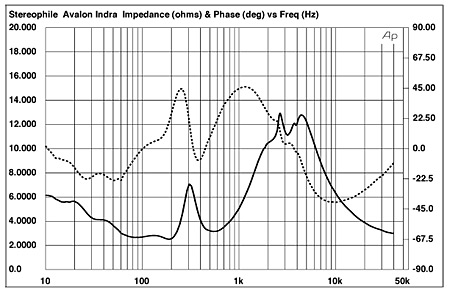
Fig.1 Avalon Acoustics Indra, electrical impedance (solid) and phase (dashed). (2 ohms/vertical div.)

Fig.2 Avalon Acoustics Indra, cumulative spectral-decay plot calculated from output of an accelerometer fastened to center of top panel (MLS driving voltage to speaker, 7.55V; measurement bandwidth, 2kHz).
Superficially, the Avalon Indra appears to be a sealed-box design, both from its physical appearance and from its impedance graph. However, there is a port on the bottom panel that fires downward, into the cavity formed by the sides of the plinth. Looking again at the impedance graph, this port appears to be tuned to 33Hz, and there is a hint of a minimum-motion notch in the woofers' nearfield response at that frequency (fig.3; the blue trace shows the summed outputs of the two woofers, which behave identically). Though the port's output covers a broader passband than usual (fig.2, red), it is well down in level and won't extend the speaker's low-frequency response by much. The summed lower-frequency response (fig.2, black) is basically that of a sealed box, with a slow rolloff below 55Hz or so. The crossover to the midrange unit (fig.2, green) appears to be set to 300Hz, though it does look as if there is not quite enough overlap, the summed lower-frequency response having a slight lack of energy through the crossover region.

Fig.3 Avalon Acoustics Indra, nearfield responses of midrange unit (green), woofers (blue), and port (red), plotted in the ratios of the square roots of their radiating areas below 900Hz, 1kHz, and 400Hz, respectively, with the complex sum of the individual responses (black) also plotted below 900Hz.
I performed most of my measurements on the Indra with its complete grille removed, as that was what WP had told me was how he auditioned the speaker. (Unfortunately, it emerged after the speakers had been shipped back that Wes misspoke: he meant without the grille cloth alone, not without the underlying felt blanket.) The blue trace above 300Hz in fig.4 shows the speaker's farfield response with the grille off, averaged across a 30° horizontal window on the tweeter axis; below that frequency is shown the summed nearfield low-frequency response from fig.3. (The usual upper-bass boost from the nearfield measurement technique disguises the expected lack of energy in the crossover region between the woofers and midrange unit.) The red trace in fig.4 is the response averaged across the same 30° horizontal window, but with the grille and felt blanket in place. Without the grille/blanket, the mid-treble is a bit uneven, and the top two octaves are lifted by up to 5dB. (This will increase the estimated sensitivity, as mentioned earlier.) But with the grille/blanket in place, the entire treble region is smoother and flatter, which is why Avalon does not recommend auditioning the Indra without the grille.
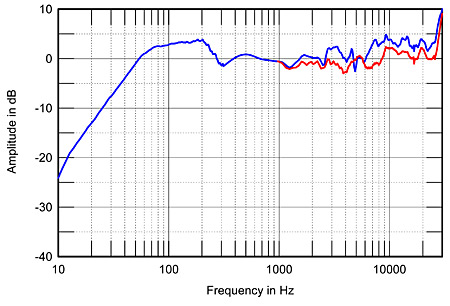
Fig.4 Avalon Acoustics Indra, anechoic response on tweeter axis at 50" without grille (blue), averaged across 30° horizontal window and corrected for microphone response, with complex sum of nearfield responses plotted below 300Hz and response on HF axis with grille (red) plotted above 1kHz.
The Indra's lateral dispersion, again without the grille, is shown in fig.5. The tweeter becomes quite directional above 10kHz, which means that in fairly large rooms—and particularly if the listener sits far away—the speaker may well sound a little lifeless. However, there is a slight flare at the bottom of the tweeter's passband that, all else being equal, might make the Avalon sound a bit too bright in very reverberant spaces. In the vertical plane (fig.6), a suckout develops in the crossover region between the midrange and tweeter more than 5° above the tweeter axis, but the response doesn't change significantly between the top of the cabinet and the midrange-unit axis.
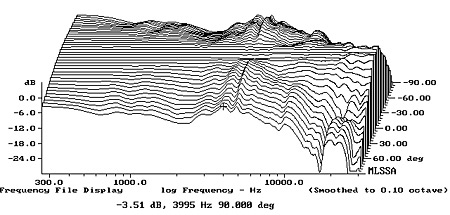
Fig.5 Avalon Acoustics Indra, lateral response family at 50", normalized to response on tweeter axis, from back to front: differences in response 90–5° off axis, reference response, differences in response 5–90° off axis.
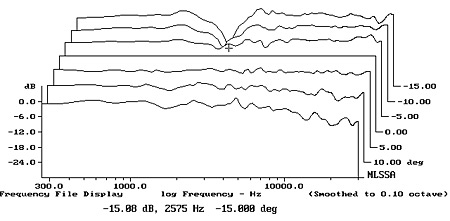
Fig.6 Avalon Acoustics Indra, vertical response family at 50", normalized to response on tweeter axis, from back to front: differences in response 15–5° above axis, reference response, differences in response 5–15° below axis.
How all this added up in WP's listening room is revealed in fig.7: the Indra's spatially averaged response, taken across a vertical rectangle centered on the position of WP's ears in his listening seat and with the felt blankets in place but not the cloth grilles. (I used an Earthworks omni microphone and a Metric Halo ULN-2 FireWire audio interface, in conjunction with SMUGSoftware's Fuzzmeasure 2.0 running on my Apple laptop.) Residual room effects lift the midbass a bit, reduce the upper bass, and give rise to a large suckout centered on 37Hz. But the 80–100Hz region is not as exaggerated as with the Wilson WATT/Puppy 8 with which WP compared the Indra and the 100–150Hz region is in better balance with the mid-bass. However, the Avalon's low bass is suppressed, as WP noted in his auditioning. The less-than-optimal integration of the woofers and midrange unit does result in a slight lack of energy in the lower crossover region, but above that frequency the Indra's in-room response is impressively smooth. As usual, the treble is shelved down, due both to the speaker's narrowing radiation pattern in this region and to the increasing absorptivity of the room's furnishings. But careful inspection indicates that there is a bit too much energy in-room above 5kHz.

Fig.7 Avalon Acoustics Indra, spatially averaged, 1/6-octave response in WP's listening room.
In the time domain, the Indra's step response on the tweeter axis (fig.8) indicates that all four drive-units are connected with positive acoustic polarity. However, the slight discontinuity between the return to the time axis of the midrange step and the start of the woofer step around the 4.5ms mark ties in with the lack of integration between these drive-units' outputs seen in the frequency domain. The Indra's cumulative spectral-decay plot (fig.9), taken on the tweeter axis with the grille removed, is generally very clean but marred by two low-level resonant modes, at 2.75 and 5.5kHz.

Fig.8 Avalon Acoustics Indra, step response on tweeter axis at 50" (5ms time window, 30kHz bandwidth).
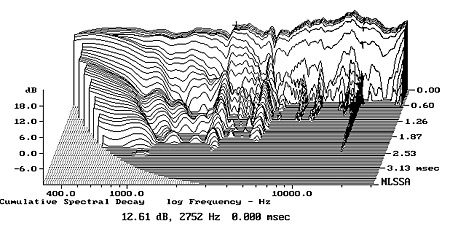
Fig.9 Avalon Acoustics Indra, cumulative spectral-decay plot on tweeter axis at 50" (0.15ms risetime).
Overall, the Indra measures well, but its restricted low-bass output may well be a problem for some listeners. However, the overdamped nature of its bass tuning will make it a good candidate for use with a subwoofer. I have asked for the review samples to be returned so I can repeat the dispersion and cumulative spectral-decay measurements with the grilles and felt blankets in place, as well as auditioning this promising design in my own room.—John Atkinson
- Log in or register to post comments




































